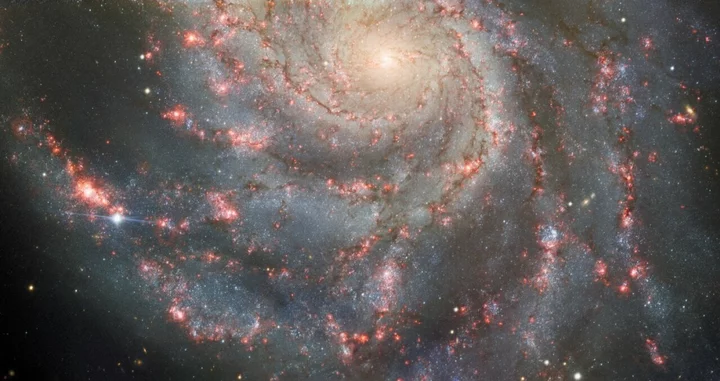Boom.
Last month astronomers spotted a star that exploded in the colossal Pinwheel galaxy some 21 million light-years away — which in cosmic terms is relatively close. The outburst of a massive star collapsing on itself, called a supernova, created a brilliant point of light in the galaxy, a light that is currently still visible with a small telescope.
Now, astronomers have pointed a powerful telescope at the space blast, and you can see the sustained bright flash. The huge, over eight-meter (over 26 feet) wide Gemini North telescope, located atop Hawaii's Mauna Kea at 13,824 feet, captured this supernova event.
SEE ALSO: Huge, unusually powerful explosion in space just detected by scientistsWhere is it? The supernova, dubbed "SN 2023ixf," is the radiant blueish point of light located on the far left of the image, on one of the Pinwheel galaxy's (a popular stargazing object also known as "Messier 101") spiral arms. The sun, and Earth, also inhabit a spiral arm of our Milky Way galaxy, though our medium-sized star is not massive enough to violently explode.
The supernova in the Pinwheel galaxy, located on the far left center in the image. Credit: International Gemini Observatory / NOIRLab / NSF / AURA // Image Processing: J. Miller (Gemini Observatory / NSF’s NOIRLab) / M. Rodriguez (Gemini Observatory / NSF’s NOIRLab) / M. Zamani (NSF’s NOIRLab) / T.A. Rector (University of Alaska Anchorage / NSF’s NOIRLab) & D. de Martin (NSF’s NOIRLab)Spotting such a vivid supernova is somewhat rare.
"This is the closest supernova to be discovered within the last five years and the second supernova to occur in Messier 101 within the past 15 years, following a Type I supernova observed in 2011," the National Science Foundation's NOIRLab — which runs big telescopes across the U.S. and elsewhere — said in a statement.
Want more science and tech news delivered straight to your inbox? Sign up for Mashable's Light Speed newsletter today.
Beyond the dazzling supernova, this NOIRLab image shows vivid pink clumps of light. These are regions of star formation amid vast, swirling clouds of dust and gas. The giant galaxy, which is nearly twice the diameter of our galaxy, is also teeming with extremely hot, blue stars. Our Milky Way contains at least one 100 billion stars, but "M101 is estimated to contain at least one trillion stars," explains NASA.
In our galaxy, there are giant stars getting tantalizing close, or closer, to exploding. Some of the red giant stars, like Betelgeuse in the constellation Orion, will appear extremely bright in the night sky, outshining all other stars, when it eventually explodes.
Keep watching.
"We don't know where the next supernova will come from," Or Graur, an associate professor of astronomy at the University of Portsmouth who researches supernovae, recently told Mashable.









